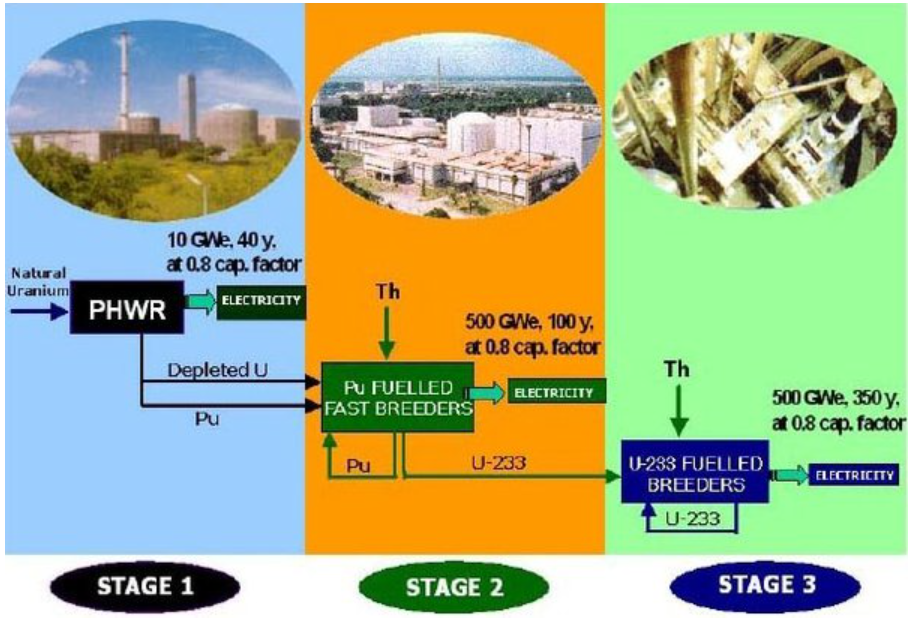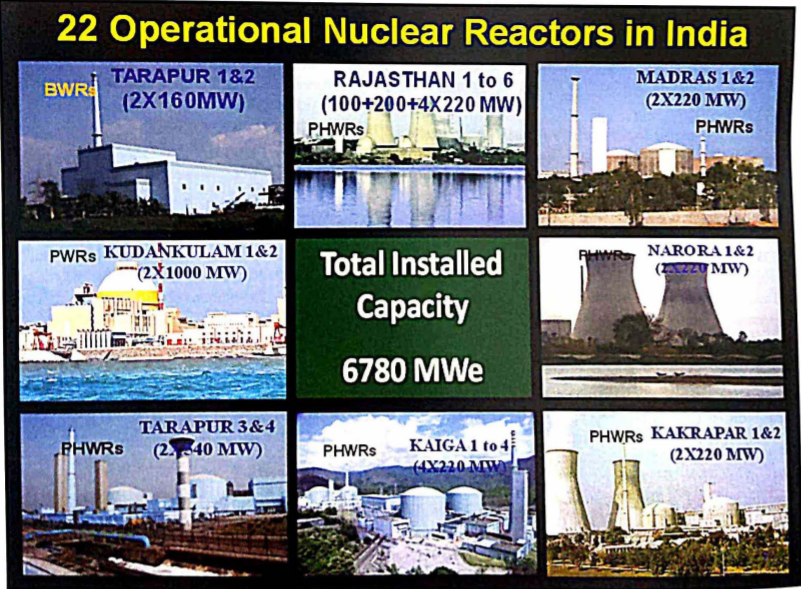ForumIAS announcing GS Foundation Program for UPSC CSE 2025-26 from 19 April. Click Here for more information.
ForumIAS Answer Writing Focus Group (AWFG) for Mains 2024 commencing from 24th June 2024. The Entrance Test for the program will be held on 28th April 2024 at 9 AM. To know more about the program visit: https://forumias.com/blog/awfg2024
Contents
- 1 Introduction
- 2 What is Energy Security and its status in India?
- 3 Status of Nuclear power in India
- 4 About India’s Nuclear power production program
- 5 What is India’s three-stage Nuclear power production programme?
- 6 India’s present and future Nuclear power plants
- 7 What is the relevance of Nuclear Power?
- 8 What needs to be done?
| For 7PM Editorial Archives click HERE → |
Introduction
Energy is the engine for economic growth and when the country moves ahead on the path of development, it is necessary to utilize every energy resource available in the country, especially nuclear power. Currently, the world is dependent on fossil fuels to match the huge amount of energy consumption across the world. This is why energy security is such an important issue.
What is Energy Security and its status in India?
Energy security means consistent availability of sufficient energy in various forms at affordable prices. These conditions must prevail over a longer period of time if energy is to contribute to sustainable development.
India’s power generation capacity has increased a hundred-fold since Independence, and it is today the third-largest producer of electricity in the world. But still, India is far behind in terms of energy security.
This is because India is also one of the world’s largest energy consumers and currently relies on imported fuels to a significant extent. The major fuel in India’s energy mix is coal 55%, a major portion of which is produced domestically. Renewable energy sources make up about 20%.
Status of Nuclear power in India
Nuclear power is considered by many as being the only source of energy suitable to support continuous industrialisation and urbanisation. But it currently provides only 3% of India’s total electricity.
Nuclear Power Corporation of India Limited (NPCIL) is the public sector enterprise under the Department of Atomic Energy entrusted with the task of nuclear power generation in the country.
But, India is planning to significantly increase the present share of electricity derived from nuclear power in the next two to three decades to reduce India’s dependence on fossil fuels.
About India’s Nuclear power production program
India has the world’s third-largest reserves of thorium. Thorium, however, cannot be used as a fuel in its natural state. It needs to be converted into its usable “fissile” form after a series of reactions. To aid this, a three-stage nuclear program was envisaged.
Dr. Homi J Bhabha envisioned the road map of the three-stage nuclear program. The program had been conceived with the ultimate objective of utilising the country’s vast reserves of thorium-232.
These three stages feed into each other in such a way that the spent fuel generated from one stage of the cycle is reprocessed and used in the next stage of the cycle to produce power. This kind of closed fuel cycle was designed to breed fuel and to minimise the generation of nuclear waste.
What is India’s three-stage Nuclear power production programme?

Stage 1: Pressurised Heavy Water Reactors (PHWRs)
In this, PHWRs will be used to produce energy from natural uranium. PHWRs do not just produce energy, they also produce fissile plutonium (Pu)-239.
Stage 2: Indigenous Fast Breeder Reactor (FBR)
The second stage involves using the indigenous Fast Breeder Reactor technology fueled by Pu-239 to produce energy and more of Pu-239.
By the end of the second stage of the cycle, the reactor would have produced more fissile material than it would have consumed, thus earning the name “Breeder.”
Stage 3: Thorium Based Reactors
The final stage of the cycle would involve the use of Pu-239 recovered from the second stage, in combination with thorium-232, to produce energy and U-233 – another fissile material – using Thermal Breeder reactors. This production of U-233 from thorium-232 would complete the cycle.
U-233 would then be used as fuel for the remaining part of the fuel cycle.
India’s present and future Nuclear power plants

Currently, there are 22 operational reactors in India with a total installed capacity of 6780 MWe (Megawatts electric). The countries first two reactors at Tarapur, Maharastra were imported. But the 220 MWe Pressurised Heavy Water Reactors (PHWRs) at Kalpakkam, Tamil Nadu was the first completely indigenous nuclear power plant. These reactors were commissioned during 1983-85.
By the 1990s, Indian nuclear scientists and engineers were ready to scale up from 220 MWe. Accordingly, two reactors of 540 MWe were commissioned at Tarapur in 2005 and 2006.
NPCIL decided to avail advantage from economies of scale and volume by upgrading further to 700 MWe capacity reactors and standardizing this design for ‘fleet construction’. Kakrapar Unit-3, the first reactor in the 700 MWe PHWR series, has been commissioned in July 2020 and is currently undergoing tests before it enters commercial operation.
At present, 10 nuclear power reactors with a total of 8000 MW capacity are under construction. Additionally, the government has accorded administrative approval and financial sanction of 10 indigenous PHWRs of 700 MW capacity each, to be set up in fleet mode.
On progressive completion, India’s nuclear power capacity is expected to reach 22480 MW by the year 2031.
What is the relevance of Nuclear Power?
Many questions will be raised on India’s nuclear power investment when India’s renewable energy share is more than 20%. But the rationale behind retaining nuclear power are,
Reduce Indian imports: Currently, India draws nearly 63% of its total energy generation from thermal sources. Of this, nearly 55% is met from coal and the rest from gas.
The worrisome part of this configuration is that India imports a significant part of its fossil fuels. For a large and rapidly developing country, bulk fuel imports raise economic and strategic vulnerabilities. Nuclear power can avert such situations.
Nuclear power’s low carbon footprint: The large-scale use of coal has severe consequences for global warming and climate change, which are critical issues besides air pollution that the planet faces today.
If a growing Indian economy continues to rely on coal, carbon emissions are bound to rise. This will impact national expenditure on domestic environmental and health measures. Nuclear energy, in this context, offers a meaningful alternative.
Limitations attached to other renewable energy sources: Renewable energy is environmental-friendly and a natural choice for India. But there are certain challenges associated with it. Such as,
-Firstly, solar and wind energy generation is land-intensive.
-Secondly, nuclear plants have become completely indigenous. Whereas solar plants require imported technology and materials such as photovoltaic cells, batteries, and storage equipment, etc.
– Thirdly, solar and wind power generation needs energy storage systems. This makes them unsuitable as a baseload source of electricity.
-Demand supply gap: There is a huge gap between energy demand and energy supply in India, due to its rapidly growing economy. So, the energy shortages in India will continue during the upcoming years. Focussing on nuclear now will help India to tackle those challenges.
What needs to be done?
-Increase cleaner and sustainable sources: India is a developing nation and its economy is dominated by the manufacturing and service sectors, which are energy-intensive. India also has to find a middle ground between economic development and environmental sustainability, which requires it to change its energy mix.
So, India should increase cleaner, sustainable, and nuclear power sources to tackle future needs.
-India needs reliable power supplies: Nearly one-third of India’s population is still not connected to any of the country’s five electricity grids. So India needs to improve its grid connectivity programs along with the development of Nuclear power.
-India should include all available energy sources: In 2018-19, India’s per capita electricity consumption was at 1181 kWh. This is very low if one can compare it with countries like Canada (17179 kWh), the US (13338 kWh), China (3000 kWh).
So, India needs to scale up electricity production to assure a reasonable quality of life for citizens. Such requirements make India enhance every available energy source.
In conclusion, given the country’s demographic growth, the aspirations of a young population, lack of indigenous fuel resources, and mounting climate change, India needs a long-term vision and commitment to safeguarding electricity for the upcoming generation.




